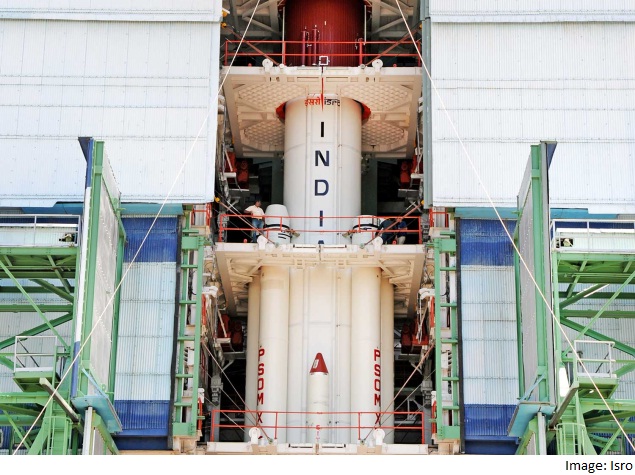- Home
- Science
- Science News
- Isro Readies PSLV Rocket for Year's First Commercial Launch on Friday
Isro Readies PSLV Rocket for Year's First Commercial Launch on Friday

The rocket will carry five British satellites together weighing around 1,440kg, said a senior official of Indian Space Research Organisation (Isro).
"The countdown for July 10 night launch of PSLV-XL (Polar Satellite Launch Vehicle-XL variant) is progressing with butter smoothness. Preparations for filling fuel in the second stage/engine is on. The second stage will be fuelled up on Friday," the official told IANS preferring not to be named.
According to him, the Friday rocket flight will be the first commercial rocket launch for Isro this calendar year. In terms of number of rocket launches for 2015, it will be second after the launch of navigation satellite-IRNSS-1D earlier in March.
The blast-off is scheduled for 9.58pm IST on Friday from the first launch pad at Sriharikota rocket port in Andhra Pradesh, around 80km from Chennai.
Since 1999 till date, India has launched 40 satellites of other countries with its PSLV rocket and the successful launch of the five British satellites would take the tally to 45.
The PSLV-XL variant costing around Rs. 140 crores is a four-stage/engine rocket with six strap-on motors for additional thrust during the initial phase of the flight.
The first and third stages are powered by solid fuel and are cast ready while the second and fourth stages are powered by liquid fuel which will be filled during the countdown.
The fuelling up of rocket's fourth stage was completed on July 8.
Apart from fuelling up the engines, all the systems would be checked and re-checked during the countdown.
According to Isro, this is the heaviest commercial luggage carried by a PSLV rocket till date.
Of the five British satellites, three are identical DMC3 optical earth observation satellites weighing 447kg. These will be put into a 647-km sun-synchronous orbit.
Of the other two satellites, CBNT-1 weighs 91kg and also is an optical earth observation technology demonstration microsatellite, while the De-OrbitSail weighs 7kg. This is an experimental nano satellite for demonstration of large thin membrane sail and drag deorbiting.
The total duration - from the rocket's blast off to the fifth satellite separation - will be around 19 minutes 16 seconds.
The three DMC3 and the CBNT-1 satellites are built by Surrey Satellite Technology Ltd. The De-OrbitSail is built by Surrey Space Centre.
According to Isro, accommodating the three DMC3 satellites each with a height of about three metres within the existing payload fairing or the heat shield of the PSLV was a challenge. Thus, a circular L-adaptor and a triangular Multiple Satellite Adapter-Version 2 (MSA-V2) were newly designed and realised by Isro for this specific purpose.
France's SPOT 7 satellite weighing 714kg was the heaviest single foreign satellite carried by a PSLV rocket till now. It was launched on June 30, 2014.
On the other hand, Isro is also readying for the launch of GSAT6 communication satellite using its heavier rocket Geosynchronous Satellite Launch Vehicle (GSLV).
The GSLV rocket's first stage/engine has been assembled and the activities relating to that rocket assembly are progressing smoothly.
Only after the GSLV rocket launch the testing of a small model of reusable launch vehicle shaped like an aeroplane would be done, an Isro official told IANS earlier.
Earlier, it was said the test reusable launch vehicle would happen in July 2015.
Isro officials has told IANS that the test model reusable launch vehicle would be mounted on a strap-on solid booster of PSLV rocket with 9-tonne fuel.
At an altitude of 70 km, the model would get separated and would glide back to earth. The descent speed would be around 2 km per second.
"The descent speed would be controlled through the fins on the machine. In order to protect the equipment from friction heat when it comes back, necessary protective tiles are fixed," the Isro official had told IANS.
The experimental vehicle would weigh around 1.5 tonne which is a far cry from the actual vehicle that is expected to carry a satellite.
In December 2014, Isro sent up a 3.7 tonne giant cup cake shaped module - called Crew Module Atmospheric Re-entry Experiment - to study its re-entry characteristics, aero-braking and validation of its end-to-end parachute system.
A 630-tonne rocket went up to 126 km when the crew capsule got detached and fell into the Bay of Bengal, 20 minutes after the blast off.
The descent speed of the crew module was controlled by three parachutes.
However, the aircraft shaped vehicle will not have any parachutes to control the descent speed but the fins and other parts would do so.
Get your daily dose of tech news, reviews, and insights, in under 80 characters on Gadgets 360 Turbo. Connect with fellow tech lovers on our Forum. Follow us on X, Facebook, WhatsApp, Threads and Google News for instant updates. Catch all the action on our YouTube channel.
Related Stories
- Samsung Galaxy Unpacked 2025
- ChatGPT
- Redmi Note 14 Pro+
- iPhone 16
- Apple Vision Pro
- Oneplus 12
- OnePlus Nord CE 3 Lite 5G
- iPhone 13
- Xiaomi 14 Pro
- Oppo Find N3
- Tecno Spark Go (2023)
- Realme V30
- Best Phones Under 25000
- Samsung Galaxy S24 Series
- Cryptocurrency
- iQoo 12
- Samsung Galaxy S24 Ultra
- Giottus
- Samsung Galaxy Z Flip 5
- Apple 'Scary Fast'
- Housefull 5
- GoPro Hero 12 Black Review
- Invincible Season 2
- JioGlass
- HD Ready TV
- Laptop Under 50000
- Smartwatch Under 10000
- Latest Mobile Phones
- Compare Phones
- Honor Win RT
- Honor Win
- Xiaomi 17 Ultra Leica Edition
- Xiaomi 17 Ultra
- Huawei Nova 15
- Huawei Nova 15 Pro
- Huawei Nova 15 Ultra
- OnePlus 15R
- Asus ProArt P16
- MacBook Pro 14-inch (M5, 2025)
- OPPO Pad Air 5
- Huawei MatePad 11.5 (2026)
- Xiaomi Watch 5
- Huawei Watch 10th Anniversary Edition
- Acerpure Nitro Z Series 100-inch QLED TV
- Samsung 43 Inch LED Ultra HD (4K) Smart TV (UA43UE81AFULXL)
- Asus ROG Ally
- Nintendo Switch Lite
- Haier 1.6 Ton 5 Star Inverter Split AC (HSU19G-MZAID5BN-INV)
- Haier 1.6 Ton 5 Star Inverter Split AC (HSU19G-MZAIM5BN-INV)

















